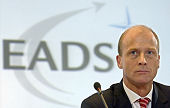 Last week, Dr. Thomas Enders, the CEO of the European Aeronautic Defense and Space Company (“EADS”) spoke at the CEO Leadership Series at the U.S. Chamber of Commerce. An article in World Politics Review describes an ITAR war story told by Dr. Enders during his speech:
Last week, Dr. Thomas Enders, the CEO of the European Aeronautic Defense and Space Company (“EADS”) spoke at the CEO Leadership Series at the U.S. Chamber of Commerce. An article in World Politics Review describes an ITAR war story told by Dr. Enders during his speech:
Offering his own “war story” concerning ITAR, Enders cited a case involving EADS and the U.S. Navy. EADS had exported U.S.-made parts for incorporation into a radar system for Malaysia, he said. When that deal . . . became sidetracked, the [parts] became available and the Navy decided that it needed them. So, in June of 2005, EADS asked the State Department for permission to re-transfer the American-made parts back to the United States.
The State Department, which is responsible for enforcing ITAR rules, took 11 months — until May, 2006 — to grant that permission, and only “when this matter was elevated to the highest management level of the Directorate [of] Defense Trade Controls in the State Department,” Enders said. Was the State Department “worried about the reliability of the Navy as end-user?” he asked rhetorically.
While noting that he was “not trying to ridicule ITAR,” Enders said that “There’s something wrong” with the current situation. “The point is [that] these regulations are so burdensome for industry on both sides of the Atlantic.” They are “strangling” U.S.-EU defense trade, he said.
Although my first thought was that these re-exports of the parts to the Navy would be covered under the exemptions in ITAR § 126.4 for shipments by or for U.S. government agencies, a closer look at them shows that not to be the case. The exemption in § 126.4(a) only applies to temporary imports and temporary exports. In this case, a permanent export was involved. Similarly, the exemption in § 126.4(c) only applies to exports for end-use by the U.S. government in a foreign country, which was also not the case.
Certainly it is an odd result that there would have been an exemption if EADS were shipping those parts back to the Navy for use outside the U.S. but no exemption if they were being shipped back for use by the Navy in the United States itself. This only makes sense if you make the otherwise reasonable assumption that the definition of re-export in § 120.19 wasn’t intended to cover a transfer of defense articles to the U.S. government in the United States. However reasonable that assumption might otherwise be, the language of § 120.19 doesn’t explicitly permit such a reading, and EADS was, therefore, required to apply for a license to cover the re-export of the parts to the Navy.
 Permalink
Permalink
Copyright © 2007 Clif Burns. All Rights Reserved.
(No republication, syndication or use permitted without my consent.)

 Posted by
Posted by  Category:
Category: 

